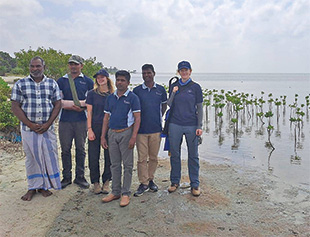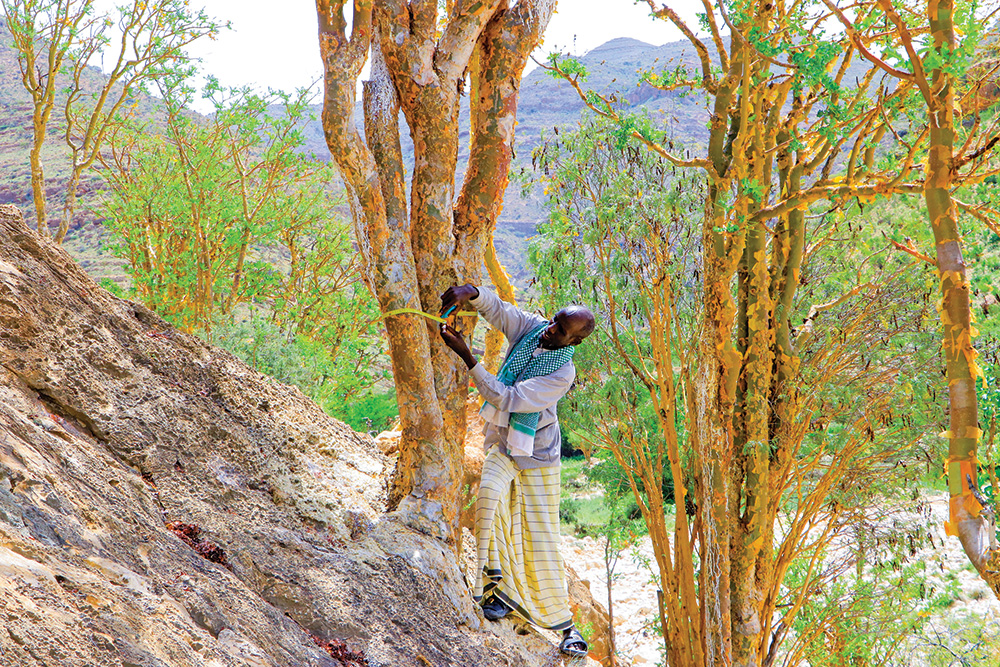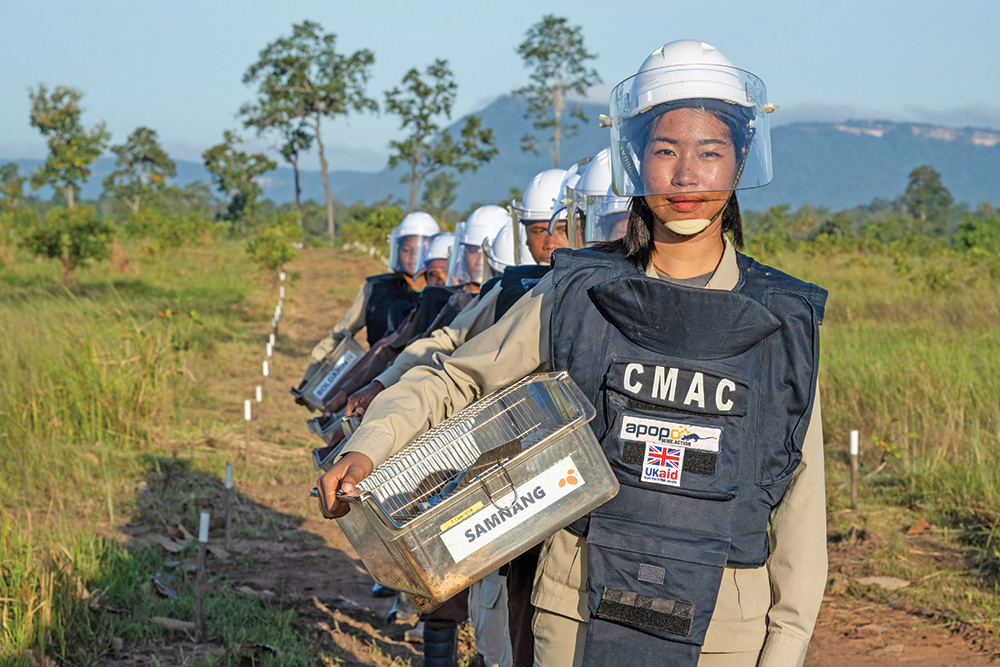No Silver Bullet: Environment and Climate Funding in Mine Action
CISR JournalThis article is brought to you by the Center for International Stabilization and Recovery (CISR) from issue 28.3 of The Journal of Conventional Weapons Destruction available on the JMU Scholarly Commons and Issuu.com.
By Christelle Mestre [ Geneva International Centre for Humanitarian Demining ]
Funding requirements, needs, and models are evolving to reflect the growing focus on environment and climate considerations in the mine action sector. This article examines current funding practices for environmental considerations within the sector and beyond, emphasizing the need for a holistic approach that looks at the broader impact of mine action. It underscores the importance of strategic partnerships, national mine action strategies, and awareness-raising efforts among donors and investors about the environmental and climate-related benefits of mine action. The article argues that while there’s no silver bullet, the integration of environmental and climate considerations into mine action can secure additional funding and contribute to global sustainability efforts.

A group of people stand along a shoreline where small mangrove trees are growing.
Introduction
The year 2024 marks a pivotal moment in mine action to reflect on environmental and climate funding. While the connections between mine action, the environment, and climate action have always existed, the urgency of the issue has intensified in the face of the triple planetary crisis humanity faces, namely climate change, air pollution, and biodiversity loss.1 A recent study by the Geneva International Centre for Humanitarian Demining (GICHD) revealed that 60 percent of the twenty countries most vulnerable to climate change are also contaminated by explosive ordnance (EO).2
The topic of funding is particularly timely with the release of the second edition of International Mine Action Standards (IMAS) 07.13 on environmental management and climate change in mine action, and the upcoming adoption of a new action plan at the Fifth Review Conference of the Anti-Personnel Mine Ban Convention (APMBC), which should address these considerations. Additionally, government donors are increasingly incorporating environment and climate action requirements into their funding tenders.
Acknowledging that the topic of funding is vast and multifaceted, this article provides an initial overview on evolving needs, requirements, and funding models, highlighting experiences and lessons learned from a few select organizations. It emphasizes the need for all actors to converge and enhance the sector’s effectiveness in mainstreaming environmental and climate action considerations. Recognizing the absence of a one-size-fits-all solution, this article underscores that progress will result from the collaborative and integrated efforts of all relevant stakeholders, starting now.
State of Play
Environment refers to the surroundings in which an organization operates, while climate action involves efforts to reduce or prevent greenhouse gas emissions and strengthen resilience and adaptive capacity to climate-induced impacts.3 In mine action, activities associated with environment and climate action vary widely and are often tailored to specific national contexts. They encompass diverse initiatives such as reducing greenhouse gas emissions from operations through sustainable capital equipment (e.g., solar panels), promoting circularity4 (e.g., personal protective equipment or rubble recycling), restoring land or ecosystems post-clearance (e.g., mangrove planting), enabling sustainable agricultural or forestry practices (e.g., agroforestry), supporting conservation and eco-tourism in national parks, and more.
These activities frequently begin as side projects initiated by a mine action organization’s country programs or headquarters. However, there is a growing trend toward the institutionalization of these efforts, evidenced by the development of organizational environmental strategies or policies and the establishment of dedicated staff positions focused on institutional and programmatic levels.
The second edition of IMAS 07.13 notes that “the most effective way of reducing the direct impact of mine action operations on land is through the application of land release principles.”5 The IMAS also introduces new requirements and clearly defined responsibilities for National Mine Action Authorities (NMAAs), mine action organizations, and donors. IMAS 07.13 is expected to have a profound impact on operations, if adopted through National Mine Action Standards (NMAS) and implemented diligently. Achieving broad stakeholder buy-in from NMAAs, mine action organizations, and donors will be crucial in translating these new requirements into actionable reality.
Evolving Needs and Requirements
There is a growing trend among government donors to request more information from grantees on efforts to mitigate and monitor greenhouse gas emissions.6 Mine action donors are also increasingly inclined to support activities related to the environment or climate action, aligning with their own environmental and climate national commitments, as well as regulations on official development assistance.
States affected by EO contamination also have national commitments and regulations on environment and climate action, which all organizations shall comply with.7 As the sector prepares for the Fifth Review Conference of the APMBC, many mine action stakeholders are calling for the integration of specific actions relating to environment and climate in the new action plan.8 NMAAs will have an increasing responsibility to integrate environmental and climate action into all aspects of mine action programs.
These new requirements will likely increase funding needs in the sector. In the short term, organizations will need to establish new systems and acquire capital equipment, potentially raising both overhead and operational costs. This includes implementing environmental management systems and acquiring technologies for green organizations and operations (e.g., solar panels in camps or offices). While these investments may involve initial additional costs, they are expected to yield long-term savings and reduce greenhouse gas emissions. However, realizing these benefits depends on securing funding for equipment and systems that often outlast the duration of donor grants, highlighting the importance of sustained donor commitment.
The sector should enhance its capacities to manage and implement mine action activities effectively, as outlined in the revised IMAS. In the short term, this will entail improving environmental and climate literacy across the sector through capacity enhancement. It may also necessitate creating new staff roles such as environmental leads or focal points, which may incur additional costs. Furthermore, this will likely require forging new partnerships with relevant environment or climate action organizations, requiring active engagement, effective management, and initial costs. Despite these costs, such investments should yield returns over time.
In the medium to long term, in alignment with IMAS requirements, organizations should pay more attention to planning and tasking as well as post-clearance land use, ensuring that “the environment is left in a state that is similar to or, where possible, better than before the start of mine action operations.”9 As NMAAs adopt revised NMAS aligned with IMAS 07.13, there will be a growing need to clarify the long-term financial implications of fully mainstreaming environmental and climate change considerations into national mine action programs, including assessing potential delays in achieving clearance targets and effects on time-bound treaty obligations, including APMBC Article Five. An effective approach will be to include environmental and climate action into priority-setting systems, national mine action strategies, and costed work plans.
Finally, the costs of inaction can also be substantial, as land contaminated by EO is often left unused, missing opportunities for sustainable agriculture, environmental protection, or renewable energy infrastructure, such as solar power plants. This unused land results in communities losing out on both monetary benefits, such as agricultural production, and non-monetary benefits, like healthy ecosystems.
... the costs of inaction can also be substantial, as land contaminated by EO is often left unused, missing opportunities for sustainable agriculture, environmental protection, or renewable energy infrastructure ...

Mapping of Funding Models
Recent analysis estimates a US$1.69 billion funding gap for seventeen States to meet their land release commitments. This figure would likely be significantly higher if extended to all EO-affected countries and territories.10 Given this substantial funding shortfall and the increased focus on environment and climate action in mine action, critical questions arise: How will these aspects be funded in the future? Which funds are currently accessible for mine action stakeholders?
Bilateral government funding. The mine action sector relies heavily on government donor funding, predominantly from a small group of dedicated state donors. From 2011 to 2022, the top six donors consistently provided over 70 percent of the annual international funding for mine action. Since 2017, this group has remained unchanged: the United States, Germany, Japan, the United Kingdom, the European Union, and Norway. In parallel, nineteen countries and territories contributed funds to their own national mine action programs during this period, with Angola, Croatia, and Bosnia and Herzegovina being the top national donors in terms of cumulative contributions.11 No data currently exists on international and national institutional funding for environment and climate action in mine action.12
Many government donors and EO-affected countries have national legislation and commitments under international treaties that are increasingly demanding, reflecting the high priority of environmental protection and addressing climate change for national governments. Many donor- and EO-affected States are parties to environment and climate change-related conventions, such as the Convention on Biological Diversity (CBD) or the United National Framework Convention on Climate Change (UNFCCC). Notably, 84 percent of UNFCCC state parties are parties to the APMBC.13 The CBD Conference of the Parties (COP) 16 in Colombia and UNFCCC COP29 in Azerbaijan in late 2024 offer key opportunities to include mine action in broader environmental and climate change fora, particularly since both host countries are affected by EO contamination.
Additionally, many donor countries have endorsed national development policies requiring the integration of environment and climate action considerations, including the six primary donors to mine action.14,15,16,17,18,19 Furthermore, twenty-eight humanitarian donors have committed to supporting the humanitarian system in preventing, preparing for, anticipating, and responding to climate and environmental risks and impacts, as outlined in the Humanitarian aid donors’ declaration on climate and environment.20 Countries such as Germany have gone a step further by incorporating environment and climate action into their mine action strategies.21

Donors’ legal, political, and policy commitments are increasingly well-defined. However, several critical questions remain: How can these commitments effectively translate into actionable initiatives in mine action? Will traditional donors increase their funding to incorporate environmental and climate aspects, or will these donors maintain similar funding envelopes, potentially de-prioritizing other mine action activities in an already challenging funding environment? Can the links between mine action and environment and climate action help preserve or expand funding for mine action? Can international treaties and commitments be leveraged to increase mine action funding and support for environmental and climate action components? Can mine action organizations tap into funding from other ministries or state agencies, with the support of traditional donors, without creating additional administrative burdens? What mechanisms could be established within donor states to facilitate mine action stakeholders’ access to official development assistance funds?
Given current funding shortfalls in mine action generally and increasing funding needs for environment and climate, government donors have a critical role to play. They could advocate for integrated funding, leveraging multi-sectoral partnerships, enhancing donor coordination, streamlining access to funds, and demonstrating environment and climate co-benefits of mine action within their governments, supported by relevant stakeholders.
Initiatives like Germany’s International Climate Initiative (IKI), a cross-ministerial funding program coordinated by the Federal Ministry for Economic Affairs and Climate Action and implemented in close cooperation with the Federal Ministry for the Environment, Nature Conservation, Nuclear Safety and Consumer Protection, as well as the Federal Foreign Office (under which mine action falls), could offer promising avenues to bridge some of these gaps.22 Additionally, multi-donor trust funds provide opportunities for government donors to collaborate on shared interests, including on environmental protection and climate action.23
Foundations and dedicated funds. Beyond direct government funding, a variety of alternative funds could support environment and climate action efforts in mine action. These include corporate or private foundations, specialized funds (including donor trust funds) dedicated to environment, climate, or conservation efforts, the private sector, and international organizations. These entities derive funding from various sources including individual donations, corporate contributions, or government funding. Such funding can be global in reach or specific to certain regions and can target large programs or small projects.

Innovative finance mechanisms can help fund mine action by showing investors the tangible and intangible value that safe and cleared land can provide.
There is currently no inventory of foundations and funds dedicated to environment and climate, which could benefit the mine action sector. However, specialized resources such as the Climate Funds Update provide comprehensive information on the climate finance architecture,24 including the financial mechanisms and funds associated with the implementation of the CBD and UNFCCC.25
This broad diversity presents numerous opportunities but also requires careful navigation to identify the most suitable sources of funding for interested organizations. Moreover, the accreditation and bidding processes for some large, specialized funds can be resource-intensive, creating barriers for those without significant administrative capacity. Some foundations or funds also often require partnerships with specialized organizations.
International organizations or UN agencies like the United Nations Environment Programme (UNEP) may offer other alternatives by providing direct funding or offering in-kind contributions, such as expertise on environmental or climate-related subjects. Some international organizations may outsource specific aspects of their work and seek mine action partners for survey and clearance purposes.
Access to foundations and dedicated funds can often rely on partnerships with established and experienced organizations working in the fields of sustainability, environment, climate, or conservation. Some mine action organizations like The HALO Trust (HALO) have adopted this model, leveraging their partners’ credibility and networks to secure funding. Collaborating with established entities not only enhances funding prospects but also brings additional expertise and resources to mine action projects.
Foundations such as The Nature Conservancy26 (focusing on conservation) and programs like Innovation Norway27 (with a broader scope) have provided critical funding to HALO and Norwegian People’s Aid respectively in support of environment- and climate-related projects. These contributions have been invaluable in piloting new approaches and demonstrating the impact of projects to larger donors.
Innovative finance mechanisms. The potential for innovative finance in mine action is increasingly recognized. Innovative finance mechanisms can help fund mine action by showing investors the tangible and intangible value that safe and cleared land can provide.28 Few instances of applying innovative finance models to mine action exist, with two examples presented here:
- The outcome-based payments (OBP) scheme has been used by the mine action organization APOPO in Cambodia. OBP is a funding model where payments are made based on the achievement of specific outcomes. In Cambodia, private investors provided upfront funding for initial implementation. APOPO’s teams cleared landmines, while the agricultural nongovernmental organization (NGO) Cordaid trained farmers to grow and sell organic rice at a premium. The UK Development Investment Bond repaid the investors (plus interest) once the pre-approved outcomes were achieved, and the outcomes validated by a third-party verifier.
- The payments for ecosystem services (PES) scheme has been used by the Government of Croatia to fund mine action activities in Natura 2000 sites. PES involves users of ecosystem services making payments to the providers of these services.29 Under Croatia’s Forest Act, forest users pay a fee to use the forests, with 30 percent of the collected funds going toward demining activities in forests.30
Additional innovative funding models could be further explored:31
- Sustainable bonds are financial instruments issued to raise capital for projects that have positive environmental and social impacts, alongside financial returns. In mine action, sustainable bonds could fund large-scale mine action projects which include environmental or climate action aspects. Interested entities could issue sustainable bonds (loans), which are sold to investors focusing on Environmental, Social, and Governance criteria. These funds would support mine action projects with environmental and climate aspects. Income generated from the land after clearance (e.g., through placement of renewable energy or regenerative agriculture) could be used to repay the investors. Bond issuers also provide investors with detailed reports on the impacts of the bond-funded projects.
- Carbon credits are a market-based mechanism where outputs from climate change projects (reductions in greenhouse gas emissions, increases in carbon sequestration,32 management of grazing land or renewable energy) can be sold as credits. In mine action, a reforestation project could be initiated on cleared land, where trees planted would sequester carbon dioxide (CO2). Once the pilot project has been verified by a certified party, the project could generate carbon credits (funds from carbon sold on the market) to fund further mine action and reforestation activity.
Establishing such innovative finance mechanisms requires significant institutional commitment and political will. The issue of scale is also crucial: models like OBP may suit smaller organizations, whereas bonds would likely better serve large organizations and programs. Additionally, some models, such as carbon credits, have yet to be trialed due to limited confidence and reputational risks for mine action organizations.
Innovative finance mechanisms, complementary to traditional funding approaches, have proven effective in various humanitarian aid and development assistance contexts.33 While their implementation in mine action is still in its early stages, these models could help bridge the current funding gap in the mine action sector and address growing funding needs related to environmental and climate action.
Establishing such innovative finance mechanisms requires
significant institutional commitment and political will.
Key Lessons Identified
At the national level, a crucial step is for NMAAs to enhance coordination with environmental and climate change authorities and align mine action policies, strategies, standards, and procedures with national environmental and climate change frameworks. Another key step is for NMAAs to integrate environmental protection and climate resilience in priority-setting and tasking systems.34 National mine action programs, with the lead of NMAAs, have a critical role to play in establishing the connection between mine action and the environment, actively engaging with actors outside of mine action, and making mine action information accessible to other sectors, as relevant to national contexts. Raising awareness among investors, foundations, and non-mine action institutional donors about the sector’s broad impact will be crucial in making this happen.
While funding opportunities exist for integrating environment and climate action into mine action, they come with inherent challenges and limitations. One primary challenge is the need for the sector to adapt its mindset and view mine action through the lens of environmental and climate action. This requires adopting a more holistic approach to mine action, considering post-clearance land use and the wide-ranging co-benefits that mine action enables in terms of environmental conservation, climate adaptation, and climate resilience. This approach positions the sector as a precursor to broader environmental protection efforts.35
To attract new funding, the sector can leverage its extensive experience working in fragile or conflict contexts, which environmental or climate-related organizations might struggle to access. Mine action organizations have unique entry points in these difficult contexts, serving communities affected by EO. This privileged access and logistical setup, with organizations often equipped to reach very remote areas, provides opportunities for environmental or conservation NGOs to safely access areas or gain the trust of communities for environmental purposes. This collaboration can create synergies that benefit both mine action and environmental initiatives.
Partnerships present significant opportunities for attracting additional funding sources, both to finance mine action and to mainstream environmental considerations. While some organizations are beginning to invest in this area, the entire sector—including NMAAs and donors—needs to join forces to turn these opportunities into actionable reality for the benefit of communities affected by EO.
Testing and exploring alternative funding models can generate interest in the sector and influence new donors to support mine action. Changing mindsets is crucial—seeing mine action as an investment in climate resilience, whether by strengthening livelihoods, environmental protection, or sustainable infrastructure projects—and can shift the focus toward the impacts of mine action and drivers of sustainable growth.
Mine action is well-placed to participate in the transition to a more sustainable world. There is no silver bullet solution, but there are many opportunities, and the time to act is now. By integrating environmental and climate action considerations into mine action, the sector can not only secure additional funding but also contribute significantly to global sustainability efforts.
See endnotes below
The author would like to thank those who have contributed to this article by sharing experiences and lessons learned (in alphabetical order): Emily Chrystie (The HALO Trust), Linsey Cottrell (Conflict and Environment Observatory), Alex Frost (Mine Action Review), Laura Frühwald (Trafigura Foundation), Hesta Groenewald (PeaceNexus), Andreas Luis Hahn (Organization of American States), Camille Wallen (Symbio Impact Ltd), and Rob White (Norwegian People’s Aid).
 Christelle Mestre is a Strategic Planning Advisor at the Geneva International Centre for Humanitarian Demining (GICHD), where she supports explosive-ordnance-affected as well as donor countries in developing, implementing, and reviewing their mine action strategies. She leads the integration of environmental considerations into strategic planning processes at the GICHD. Mestre is a Registered Environmental Practitioner (REnvP) with the UK Society for the Environment and an Institute of Enviornmental Management and Assessment Practitioner. Prior to her current role, she worked with the peacebuilding organization Interpeace.
Christelle Mestre is a Strategic Planning Advisor at the Geneva International Centre for Humanitarian Demining (GICHD), where she supports explosive-ordnance-affected as well as donor countries in developing, implementing, and reviewing their mine action strategies. She leads the integration of environmental considerations into strategic planning processes at the GICHD. Mestre is a Registered Environmental Practitioner (REnvP) with the UK Society for the Environment and an Institute of Enviornmental Management and Assessment Practitioner. Prior to her current role, she worked with the peacebuilding organization Interpeace.

